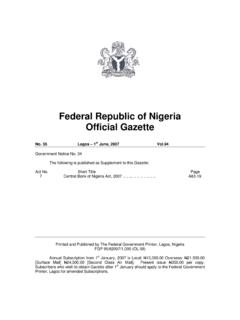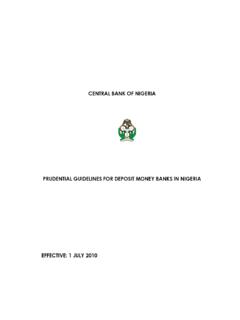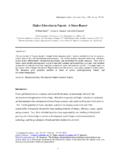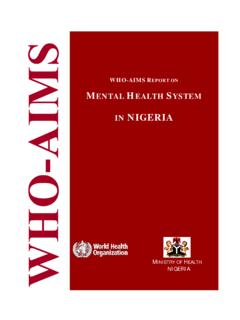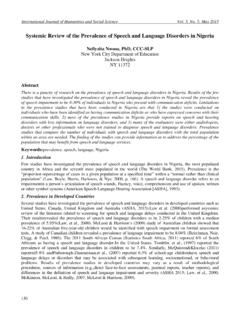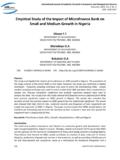Transcription of Case Study IV* - Nigeria - WHO
1 Water Pollution Control - A Guide to the Use of Water Quality Management Principles Edited by Richard Helmer and Ivanildo Hespanhol Published on behalf of the United Nations Environment Programme, the Water Supply & Sanitation Collaborative Council and the World Health Organization by E. & F. Spon 1997 WHO/UNEP ISBN 0 419 22910 8 case Study IV* - Nigeria * This case Study was prepared by Lawrence Chidi Anukam Introduction Nigeria is located approximately between latitude 4 and 14 North of the Equator, and between longitudes 2 2' and 14 30' East of the Greenwich meridian (Figure ). It is bordered to the north by the Republics of Niger and Chad, to the south by the Atlantic Ocean, to the east by the Republic of Cameroon and to the west by the Republic of Benin.
2 The population is more than 100 million, spread unevenly over a national territory of 923,770 km2. Nigeria has the eighth largest national population in the world and about a quarter of the total population of all the countries in Sub-Sahara Africa. The climate, which affects the quality and quantity of the country's water resources, results from the influence of two main wind systems: the moist, relatively cool, monsoon wind which blows from the south-west across the Atlantic Ocean towards the country and brings rainfall, and the hot, dry, dust-laden Harmattan wind which blows from the north-east across the Sahara desert with its accompanying dry weather and dust-laden air. The mean temperature is generally between 25 and 30 C (77 and 86 F), although because of the moderating influence of the sea the mean daily and annual maximum temperatures increase from the coast towards the interior.
3 In the dry season the temperatures are more extreme, ranging between 20 and 30 C (68 and 86 F). Water resources Nigeria has abundant water resources although they are unevenly distributed over the country. The highest annual precipitation of about 3,000 mm occurs in the Niger Delta and mangrove swamp areas of the south-east, where rain falls for more than eight months a year. There is a progressive reduction in precipitation northwards with the most arid north-eastern Sahelian region receiving as little as 500 mm a -1 precipitation from about 3-4 months of rainfall. Widespread flooding occurs in the southern parts of the country, while the northern parts experience chronic water shortages during the dry season when rainfed springs, streams and boreholes dry up.
4 Figure Location map of Nigeria There are four major drainage systems in the country (Figure ): The Niger River Basin Drainage System with its major tributaries of Benue, Sokoto-Rima, Kaduna, Gongola, Katsina-Ala, Donga, Tarabe, Hawal and Anambara Rivers. The Lake Chad Inland Drainage System comprising the Kano, Hadejia, Jama'are Misau, Komadougou-Yobe, Yedoseram and Ebeji Rivers. The Atlantic Drainage System (east of the Niger) comprising the Cross, Imo, Qua Iboe and Kwa Rivers. The Atlantic Drainage System (west of the Niger) made up of the Ogun, Oshun, Owena and Benin Rivers. Apart from the Lake Chad Inland Drainage System, the remaining three drainage systems terminate in the Atlantic Ocean with an extensive network of delta channels (Figure ).
5 Groundwater resources are limited by the geological structure of the country (Figure ), more than half of which is underlain by the Pre-Cambrian Basement Complex, composed mainly of metamorphic and igneous rocks. However, there are fairly extensive areas of fractured schists, quartzites and metamorphosed derivatives of ancient sediments from which water is often available at great depth. The sedimentary formations such as the Tertiary deposits of the Chad-Sokoto basins, the Cretaceous deposits of the Niger and Benue troughs, and the sedimentary formation of the Niger Delta, yield groundwater in varying quantities. Figure Map of Nigeria showing major rivers and hydrological basins: 1 Niger North, 2 Niger Central, 3 Upper Benue, 4 Lower Benue, 5 Niger South, 6 Western Littoral, 7 Eastern Littoral, 8 Lake Chad Water pollution Water pollution in Nigeria occurs in both rural and urban areas.
6 In rural areas, drinking water from natural sources such as rivers and streams is usually polluted by organic substances from upstream users who use water for agricultural activities. The most common form of stream pollution associated with forestry activities is increased concentrations of soil particles washed into the stream by land disturbance. The large particles sink to the bottom and increase the bed load while, depending on the stream velocity, smaller particles remain in suspension. In the river Niger, for example, studies have shown that the suspended matter can obstruct the penetration of light and limit the photosynthetic zone to less than 1 m depth. Suspended sediments in watercourses have become a serious concern for the water supply authorities because they lead to increased water treatment costs.
7 Figure Map of the major geological formations of Nigeria Many factories in Nigeria are located on river banks and use the rivers as open sewers for their effluents. The major industries responsible for water pollution in Nigeria include petroleum, mining (for gold, tin and coal) wood and pulp, pharmaceuticals, textiles, plastics, iron and steel, brewing, distillery fermentation, paint and food. Of all these, the petroleum industry presents the greatest threat to water quality. From time to time accidental oil spillages occur which endanger local sources of water supply and freshwater living resources, especially in the rural areas. The problems associated with the lack of adequate water resources in the country threaten to place the health of about 40 million people at risk.
8 Recent World Bank studies (World Bank, 1990) suggest that it would cost in excess of US$ 109 a year to correct such problems if ground and surface water contamination goes unchecked. The people most affected tend to be the urban and landless poor. In the long-term, the present level of environmental degradation could create health problems from water-borne diseases for most of this population. Many people are already affected by having to consume unsafe drinking water. Water contamination also places other resources at risk; fisheries and land resources, for example, have already been affected significantly. Most of the environmental pollution problems arise from anthropogenic sources, mainly from domestic and industrial activities.
9 National environmental policy The Federal Environmental Protection Agency The Federal Military Government has placed great importance on the environment and established the Federal Environmental Protection Agency (FEPA) by Decree 58 of 30 December 1988 (FGN, 1988a). The FEPA has statutory responsibility for overall protection of the environment and its initial functions and priorities included: Co-ordinating all environmental activities and programmes within the country. Serving as the national environmental focal point and the co-ordinating body for all bilateral and multilateral activities on the environment with other countries and international organisations. Setting and enforcing ambient and emission standards for air, water and noise pollution.
10 Controlling substances which may affect the stratosphere, especially the ozone layer. Preventing and controlling discharges to air, water or soil of harmful and hazardous substances. The National Policy on Environment The National Policy on the Environment was launched by the President in Abuja on 27 November 1989 (FEPA, 1989). The goal of that policy was to achieve sustainable development in Nigeria and, in particular to: Secure for all Nigerians a quality environment adequate for their health and well-being. Conserve and use the environment and natural resources for the benefit of present and future generations. Restore, maintain and enhance ecosystems and ecological processes essential for the functioning of the biosphere and for the preservation of biological diversity and to adopt the principle of optimum sustainable yield in the use of living natural resources and ecosystems.










